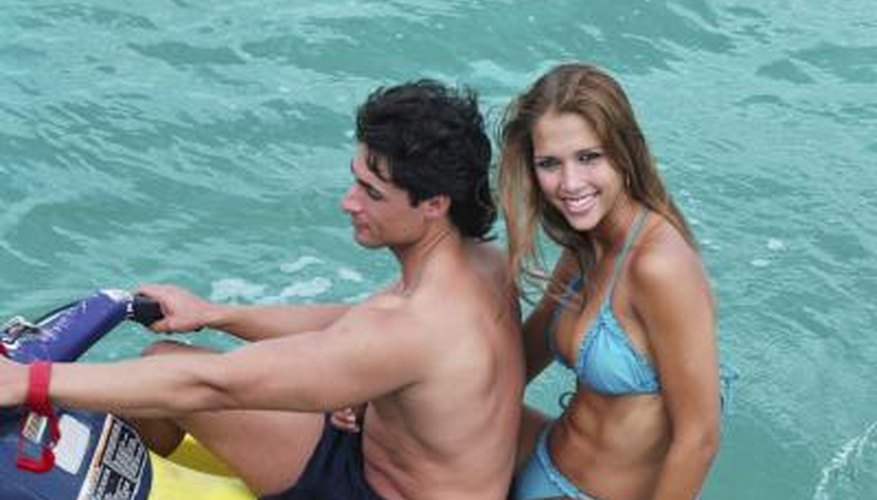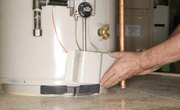
The Yamaha WaveRunner can be a delight when everything works properly, but a puzzlement when things don't go as expected. Proper maintenance requires you to flush the WaveRunner's engine of salt, silt and other nastiness after every excursion. When the WaveRunner responds to this kindness by overheating after you flush it, something is amiss. The key to diagnosing the problem lies not so much in flushing the WaveRunner properly as it does in watching the WaveRunner's reactions when you flush it.
Items you will need
Water hose
Flat-blade screwdriver
Low-pressure air compressor
Ratchet
55 mm socket
Plastic scraper
Gasket sealer
New exhaust manifold gasket
Step 1
Level the WaveRunner to the greatest extent possible, whether on the ground or on its trailer. Clear any weeds and other debris from the intake grate. Ensure the hose connector is properly connected to the engine flushing port. Start the engine. Wait 15 seconds and turn the water hose on. Flush the engine and listen for the overheating alarm.
Step 2
Take note of the places from whence the WaveRunner discharges water during the flushing procedure. Water should pour from the exhaust, the impeller gate and the cooling ports if the engine's cooling lines and jet pump are unobstructed.
Step 3
Lift the latch under the back lip of the rear seat and remove the seat to access the battery box. Disconnect the WaveRunner's battery by removing the battery cables -- negative cable first -- from the battery posts.
Step 4
Trace the cooling system hoses and inspect the ends of the cooling system hoses for deformation or cracks. Disconnect them one at a time. Some are held in place by hose clamps -- you'll need a flat-blade screwdriver to loosen the clamps -- while others simply push onto the fitting to which they are connected.
Step 5
Blow low pressure compressed air -- 30 psi or less -- through each of the hoses after you remove it from the vessel. After you've blown out every cooling system hose, reconnect the battery. Flush the motor once more and keep an eye on the discharge from the impeller gate, the exhaust and the cooling ports. If the overheating alarm sounds, clean debris from the exhaust manifold or deliver the WaveRunner to a dealer for that service.
Clearing the Exhaust Manifold
Step 1
Disconnect the battery once more. Lift the latch under the back lip of the front seat and remove the front seat. Loosen the hose clamp on the hose on the water supply inlet of the exhaust manifold, using a flat-blade screwdriver. Slide the hose clamp back onto the hose and push the hose from the inlet.
Step 2
Remove the bolt at the bottom-center of the exhaust manifold, using a ratchet and 55 mm socket. Remove the bolt at the bottom-front of the manifold, using the ratchet and socket.
Step 3
Remove the 55 mm lock-nut inside the bend of the exhaust manifold with the socket and ratchet. Pull the exhaust manifold up and away from the engine block. Remove and discard the exhaust manifold gasket.
Step 4
Blow low-pressure air through the exhaust manifold water supply inlet, until debris ceases to come from the manifold.
Step 5
Scrape any gasket material or gasket sealer from the mating surfaces of the block and manifold, using a plastic scraper.
Step 6
Apply gasket sealer to both sides of a new exhaust manifold gasket. Insert the two 55 mm bolts through the bottom-center and bottom-front of the manifold, ensuring the longer bolt goes through the bottom-center bore.
Step 7
Fit the new gasket into place on the exhaust manifold. Push the manifold back into place on the engine block. Thread the lock-nut onto the stud and tighten with your fingers. Thread the two 55 mm bolts into their respective bores on the engine block.
Step 8
Tighten the lock-nut to 11 foot-pounds with a torque wrench. Tighten both 55 mm bolts to 16 foot-pounds.
Step 9
Tighten the lock-nut to 28 foot-pounds. Tighten both 55 mm bolts to 28 foot-pounds. Reconnect the battery and flush the engine once more. If the overheating alarm does not sound, replace both seats. If the overheating alarm sounds once more, take the WaveRunner to the dealer for service.
Warnings
- Disconnect the negative cable of your battery before performing any maintenance work on your boat’s electrical system to prevent an unintended start. Lift the cable from your battery, move it outside of the battery box and close the lid of the battery box. After the work is complete, reconnect the negative battery cable.
Tips
- Having the WaveRunner properly leveled is important. Using the random water hose at an obscure boat landing doesn't ensure the hose has sufficient water pressure to overcome the effects of gravity, if the WaveRunner isn't level.
- Allow the engine time to cool before you begin flushing. The engine's cylinder is aluminum, the cylinder liner is iron. Because the two metals expand and contract at different rates, flushing a hot engine causes stress cracks in the cylinder and overheating. This will cause overheating whenever you operate the motor, not just after flushing.
- Clean the engine bay after you allow the engine to cool and before you flush it. When you rinse the engine compartment with fresh water, take care not to spray the electronics. Like flushing a hot engine, this can cause problems to appear under all circumstances, not just after flushing.
- Never pull a hose from a fitting. Pulling stretches and deforms the hose. Done often enough, it renders the hose useless. Put your thumbs on the end of the hose and push it from the fitting.
- Partially or mostly clogged cooling hoses will cause the WaveRunner to overheat after flushing but not during operation because the water pressure from the hose is less than the water pressure obtained when dashing through the water.
References
- Yamaha WaveRunner XLT1200 Service Manual/Manual d'Eentretien/Wartunshandbuch/Manual del Servicio; 460068; F0V-28197-2d-C1; Yamaha Motors
Tips
- Having the WaveRunner properly leveled is important. Using the random water hose at an obscure boat landing doesn't ensure the hose has sufficient water pressure to overcome the effects of gravity, if the WaveRunner isn't level.
- Allow the engine time to cool before you begin flushing. The engine's cylinder is aluminum, the cylinder liner is iron. Because the two metals expand and contract at different rates, flushing a hot engine causes stress cracks in the cylinder and overheating. This will cause overheating whenever you operate the motor, not just after flushing.
- Clean the engine bay after you allow the engine to cool and before you flush it. When you rinse the engine compartment with fresh water, take care not to spray the electronics. Like flushing a hot engine, this can cause problems to appear under all circumstances, not just after flushing.
- Never pull a hose from a fitting. Pulling stretches and deforms the hose. Done often enough, it renders the hose useless. Put your thumbs on the end of the hose and push it from the fitting.
- Partially or mostly clogged cooling hoses will cause the WaveRunner to overheat after flushing but not during operation because the water pressure from the hose is less than the water pressure obtained when dashing through the water.
Warnings
- Disconnect the negative cable of your battery before performing any maintenance work on your boat’s electrical system to prevent an unintended start. Lift the cable from your battery, move it outside of the battery box and close the lid of the battery box. After the work is complete, reconnect the negative battery cable.
Writer Bio
Will Charpentier is a writer who specializes in boating and maritime subjects. A retired ship captain, Charpentier holds a doctorate in applied ocean science and engineering. He is also a certified marine technician and the author of a popular text on writing local history.



